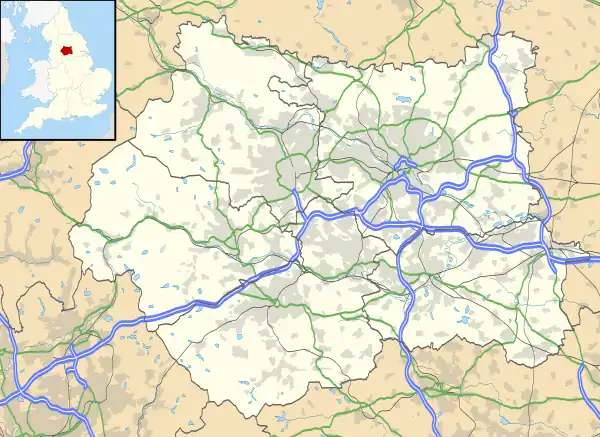| Holmfirth Civic Hall | |
|---|---|
 The building in 2007 | |
| Location | Huddersfield Road, Holmfirth |
| Coordinates | 53°34′20″N 1°47′11″W / 53.5723°N 1.7863°W |
| Built | 1842 |
| Architectural style(s) | Town hall: Neoclassical style Drill Hall: Tudor style |
Listed Building – Grade II | |
| Official name | Civic Hall, boundary wall and gate piers |
| Designated | 4 August 1983 |
| Reference no. | 1227986 |
 Shown in West Yorkshire | |
Holmfirth Civic Hall is a historic municipal building in Holmfirth, a town in West Yorkshire in England. The civic hall, which is currently used as a public events venue, is a Grade II listed building.[1]
History
The building was originally financed by public subscription and commissioned by the Holmfirth and Literary and Philosophical Society as their meeting place.[2] The site selected was on the west side of the Huddersfield Road and construction work was underway by 1838.[3] It was designed in the neoclassical style, built in ashlar stone at a cost of £2,200 and was officially opened with a dinner, a concert and a ball as Holmfirth Town Hall in 1842.[4]
The magistrates also began holding their petty sessions there,[5] and it also became an important venue for public meetings: the champion of the campaign for a ten-hour working day, Richard Oastler, held a rally in the town hall in April 1844.[6] In March 1866, a new company, known as the Holmfirth Town Hall Company, was formed to acquire the building and to promote it more vigorously as a public events venue.[7]
In the early 1890s, the complex was extended to the southwest to create a drill hall. The drill hall was designed in the Tudor style, built in rubble masonry and was completed in 1892.[8] It was commissioned to serve as the home of the 2nd Volunteer Battalion of the Duke of Wellington's (West Riding) Regiment.[9]
In 1946, Holmfirth Urban District Council purchased both buildings and refurbished them for public use: the complex was then re-opened as Holmfirth Civic Hall on 7 November 1947. However, the council continued to maintain their own offices at 49/51 Huddersfield Road until the council was abolished in 1974.[10][11][12]
The civic hall was transferred to the ownership of Holme Valley Parish Council and brought under the management of the newly-formed Holmfirth Civic Hall Community Trust in 2017.[13]
Architecture
The two-storey former town hall building is constructed of stone, and it has a flat roof. The main facade is to the south-east, and it has three central bays, with tall windows, and single-bay wings either side. The building is five bays deep.[1] The former drill hall is designed in the Tudor style, with a large hall and other rooms including an armoury.[9] The whole structure was grade II listed in 1983, along with its boundary wall and gate piers.[1]
See also
References
- 1 2 3 Historic England. "Civic Hall, boundary wall and gate piers (1227986)". National Heritage List for England. Retrieved 28 December 2023.
- ↑ Williams, Eileen (1975). Holmfirth From Forest to Township. Advertiser Press. pp. 140–141. ISBN 978-0900028205.
- ↑ "History". Holmfirth.info. Retrieved 28 December 2023.
- ↑ "Holmfirth Town Hall". Leeds Intelligencer. 30 July 1842.
- ↑ Returns of clerks of petty sessions in England. House of Commons. 9 August 1845. p. 42.
- ↑ Ward, J. T. (1962). "The Factory Movement, 1830–1855". Macmillan and Co. p. 294.
- ↑ Return relating to Joint Stock Companies. House of Commons. 20 July 1866. p. 79.
- ↑ "Our history". The Civic Holmfirth. Retrieved 27 December 2023.
- 1 2 "Holmfirth's old Drill Hall; We're on the blue plaque heritage trail". Huddersfield Daily Examiner. 25 May 2011. Retrieved 27 December 2023.
- ↑ "Guide to Tendering for Public Contracts in Ireland and the United Kingdom" (PDF). Enterprise Ireland. 2004. p. 78. Retrieved 28 December 2023.
- ↑ Local Government Act 1972. 1972 c.70. The Stationery Office Ltd. 1997. ISBN 0-10-547072-4.
- ↑ "No. 46030". The London Gazette. 17 July 1973. p. 8324.
- ↑ "Case Study: Holmfirth Civic Hall Community Trust". Rebuilding Heritage. 30 May 2022. Retrieved 28 December 2023.